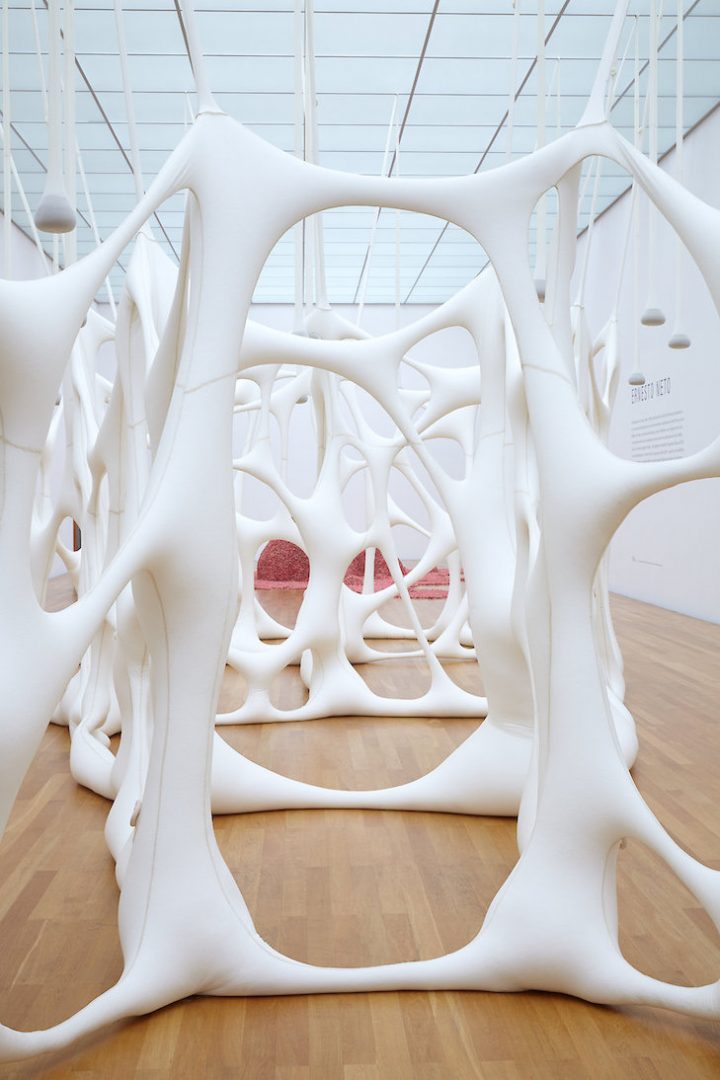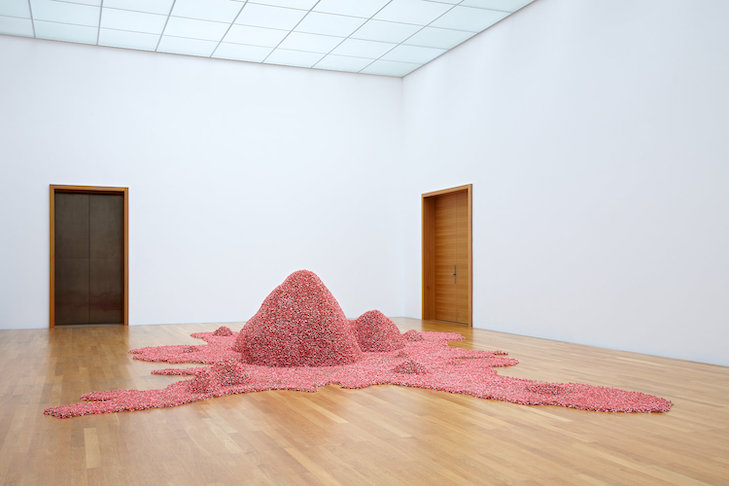The slow beat of the body that is the skin: Ernesto Neto at MdbK Leipzig
In 2008, Brad Pitt could be seen walking around Art Basel with a yellow nose. What had happened? He had gotten too close to “Antes que eu te engula carrocellflower” (Before I swallow your carrocellflower, 2007), a work by Ernesto Neto, made from elastane tulle and filled with wood spices. The Museum der bildenden Künste in Leipzig, showcases currently two installations by the Brazilian artist. And it does only take those two artworks to transform the entire central hall on the third floor of the museum into a Universe of organic forms and sensorial experiences.
Coeur et art Editor Maira Goldschmidt paid homage to the great Neto!

Three years after Brad Pitt wandered Art Basel with a yellow nose. It is 2011. New Years Evening. Ipanema Beach, Rio de Janeiro. From a small pick-up installed under a tent they are playing Sympathy for the Devil, when all of a sudden beach balls start “to float” and fly over our heads and everything and everyone transforms into this huge spontaneous performance. This was not an exhibition or staged event, but Ernesto Neto´s famous new year’s eve party.
Since 1999 it takes place always in a different spot in Rio de Janeiro and it brings together all kind of people – from celebrities to anyone.
A cool soireé where everybody and nobody is a VIP, where no one needs an invitation and where there is no dress code – my dear Berliners, you will read this and think “so what?” But believe me, society in Brazil is not so easy going as you maybe would assume or imagine. The contrary is the case. Anyway, at some point, a fashion stylist who was there more and less by chance looked around and said: “this is a significant moment that we are living through”. I couldn´t agree more.
It was a dionysiac and truly democratic experience I will never forget.

And that’s why I went to Leipzig on a sunny Sunday in February: I wanted an experience. A little bit of warm, sensual and familiar feeling to soften those days when the trees are still without leaves and nobody leaves home without a winter jacket (even if the sun shines).
Immersive Bodies: Two Installations at MdbK Leipzig
The Museum der bildenden Künste shows until the 17th of March two installations by the Brazilian artist Ernesto Neto, who is known for his biomorphic and interactive sculptural works. “Esqueleto Glóbulos” (Skeleton of Blood Cells, 2001) consists of a more than 14-meter long sculpture made from white nylon tubes, formed with polystyrene balls.
His second work on display is called “O tempo lento do corpo que é pele” (The slow beat of the body that is the skin, 2004). This piece is formed from small knots, which are a traditional Brazilian handicraft technique made by the women’s cooperative Coopa-Roca in Rio. Ernesto Neto about his creation:
The idea of skin is important to all my work: skin protects our existence and, at the same time, is the boundary point at which our innermost emotions meet our outermost actions. I perceive the body as a landscape – a lake or a field – and the sculpture is a landscape as well.

Also, the stripes of fabric are flavoured with spices like turmeric, cloves, pepper and cumin, and yes, you can smell them. But only a little. The friendly, but strict, staff of the museum don’t let the visitors get too close to his artworks; certainly not as close like Brad Pitt got at the fair; which yes caused a slight disappointment as I have had my own very selfish expectations of having a little experience and a real interaction with his art. However, a deep breath was the best way to enjoy the room and his art – and was at the end enough to bring a sense of memory back of the beautiful beach feeling, the sun and the sound of Ipanema all morphed into this unique moment, I was looking for. But back to Ernesto!

From Neo-Concretism to Tropicália: Context and Collaborations
Ernesto Neto was born in 1964 in Rio de Janeiro. Artistically he was and is influenced by the participative and political art of the 1960s in Brazil, by neo-concretism, and by the Tropicália movement. This movement aimed at creating a critical consciousness for the reception of European and North American culture and developing its own Brazilian identity, marked by eclecticism, far from stereotypes. In 2006, he was awarded for his work with the Chevalier de L’Ordre des Arts et des Lettres, presented at the Panthéon in Paris. His work was also showcased at the Venice Biennale, at Park Avenue Armory in New York or at the Guggenheim Museum Bilbao, among other places. Besides working together with the women’s cooperative Coopa-Roca, Ernesto Neto also develops artistic projects with indigenous communities, such as the Kaxinawá, who inhabits the tropical forest of eastern Peru, from the Andean foothills to the border with Brazil, and western Brazil in the states of Acre and southern Amazonas.
A trip to the MdbK is always great, in March you can also still see Elmar Trenkwalder´s monumental sculpture (until 10th) and Angelika Tübke´s works (until 23rd).
Oh and Yoko Ono is coming in April!
ERNESTO NETO – Museum der Bildenden Künste Leipzig, until 17th of March, 2019
More informations, also about the current and upcoming shows:
Photo Credits:
Ernesto Neto, Ausstellungsansicht, copyright Ernesto Neto, Thyssen-Bornemisza Art Contemporary Collection, Foto_PUNCTUM Alexander Schmidt // O tempo lento de corpo que é pele, 2014, Thyssen-Bornemisza Art Contemporary Collection, © Ernesto Neto, Foto: PUNCTUM/Alexander Schmidt // Esqueleto Glóbulos, 2001, Thyssen-Bornemisza Art Contemporary Collection, © Ernesto Neto, Foto: PUNCTUM/ Alexander Schmidt
Author: Maíra Goldschmidt
